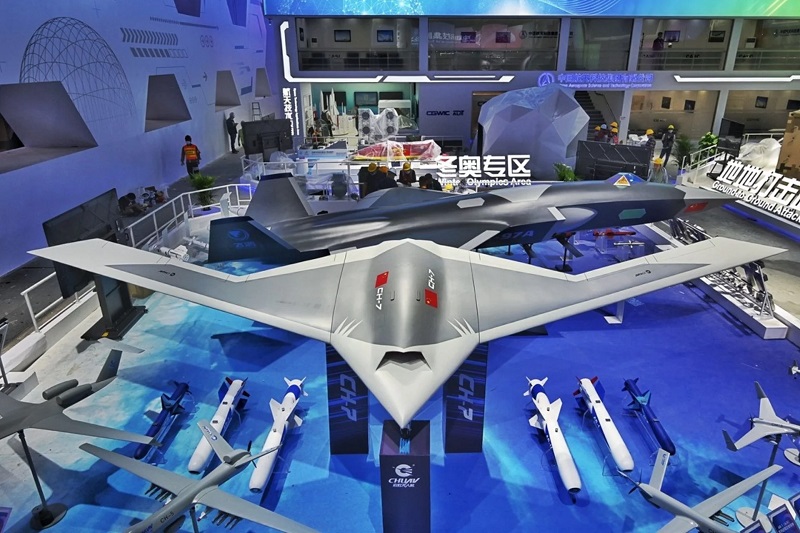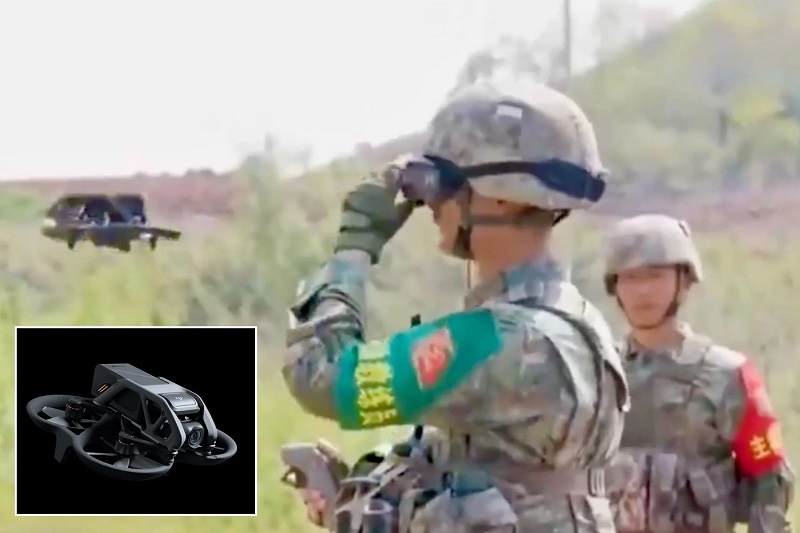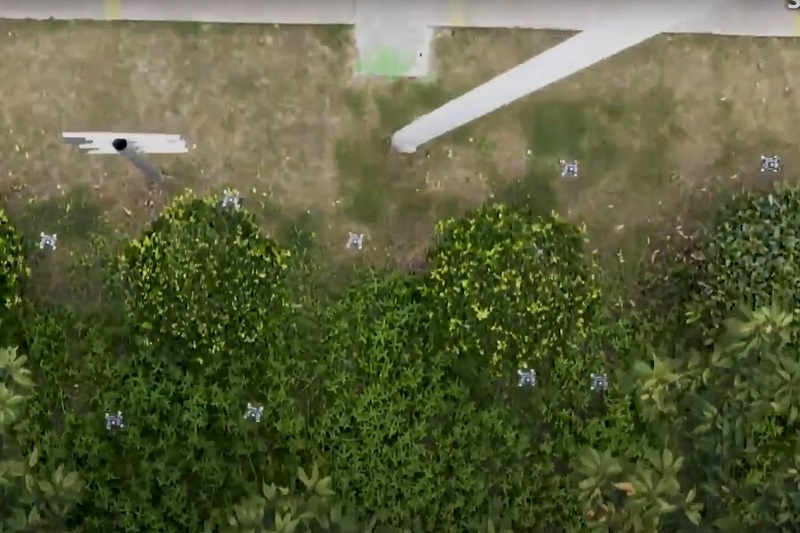| Focus China's Strategic Preparations for Next-Generation Drone Warfare
聚焦中国下一代无人机战争的战略准备 Date:2024-08-24 Source:www.armyrecognition.com By:Analysis Defense and Viewed: |
22 Aug, 2024 - 13:07
Analysis Defense and Security Industry
2024年8月22日
国防安全行业分析
For years, China has established itself as a key player in the development of military technologies, particularly in the drone sector. While many nations have also invested in this technology, China stands out due to the diversity and sophistication of its models, ranging from MALE (Medium Altitude Long Endurance) drones to ultra-small biomimetic drones. These innovations suggest that China is anticipating a new era of conflicts, where mini-drones will play a central role, both in reconnaissance missions and precision strikes.
多年来,中国已成为军事技术发展的关键参与者,特别是在无人机领域。虽然许多国家也投资了这项技术,但中国因其模型的多样性和复杂性而脱颖而出,从中高空长航时(MALE)无人机到超小型仿生无人机。这些创新表明,中国正在期待一个新的冲突时代,微型无人机将在侦察任务和精确打击中发挥核心作用。

The CH-7, also developed by CASC, represents the next generation of Chinese combat drones (Picture source: CH UAV)
中国航天科工集团公司研发的CH-7代表了中国下一代作战无人机(图片来源:CH UAV)
Chinese MALE Drones: Strategic Pillars of Chinese Military Operations
中国MALE无人机:中国军事行动的战略支柱
Drones are essential in modern military operations, particularly in ISR (Intelligence, Surveillance, Reconnaissance) missions and precision strikes. The Chinese CH-4 and Wing Loong drones are two prominent military models known for their surveillance and precision strike capabilities. The CH-4, produced by the China Aerospace Science and Technology Corporation (CASC), entered service in 2014. It is particularly valued for its versatility in ISR missions and its ability to carry out precision strikes with a range of air-to-ground munitions. The Wing Loong, developed by the Aviation Industry Corporation of China (AVIC), was first produced in 2009 and entered service in 2011. It is comparable to the CH-4 in terms of role and capabilities, offering advanced avionics systems, long endurance, and various armament options.
无人机在现代军事行动中至关重要,特别是在ISR(情报、监视、侦察)任务和精确打击中。中国的CH-4和翼龙无人机是两种闻名的军用型号,以其监视和精确打击能力而闻名。中国航天科技集团公司(CASC)生产的CH-4于2014年投入使用。它因其在ISR任务中的多功能性以及使用一系列空对地弹药进行精确打击的能力而特别受到重视。中国航空工业集团公司(AVIC)开发的“翼龙”于2009年首次生产,并于2011年投入使用。它在作用和能力方面与CH-4相当,提供先进的航空电子系统、长航时和各种武器选择。
Both drones are in service with the Chinese military and have been exported to several countries, including Pakistan, Egypt, and Saudi Arabia. The CH-4 has been highly successful in the export market due to its cost-effectiveness and performance, with hundreds of units produced. The Wing Loong, with its variants such as the Wing Loong I and II, has also seen significant production and international adoption.
这两种无人机都在中国军方服役,并已出口到巴基斯坦、埃及和沙特阿拉伯等几个国家。由于其成本效益和性能,CH-4在出口市场上非常成功,生产了数百架。翼龙及其改型,如翼龙I和II,也得到了大量的生产和国际采用。
These drones can fly at altitudes ranging from 5,000 to 7,500 meters, with endurance ranging from 14 to 20 hours, and can carry payloads for reconnaissance and strike missions. Their ISR and strike capabilities make them strategic assets in modern military operations.The CH-7, also developed by CASC, represents the next generation of Chinese combat drones. This stealth drone was first unveiled at the Airshow China in 2018 and is currently in advanced development, with entry into service expected in 2024.
这些无人机可以在5000至7500米的高度飞行,续航时间为14至20小时,可以携带侦察和打击任务的有效载荷。他们的ISR和打击能力使他们成为现代军事行动中的战略资产。同样由CASC开发的CH-7代表了中国下一代作战无人机。这款隐形无人机于2018年在中国航展上首次亮相,目前正处于高级开发阶段,预计将于2024年投入使用。
The CH-7 stands out for its flying wing design, optimized for stealth, allowing it to reduce its radar signature and penetrate heavily defended areas. With a wingspan of 26 meters and a service altitude reaching 15 kilometers, it is designed for prolonged reconnaissance and surveillance missions, as well as precision strikes. This drone can also be armed with missiles and guide other weapons to strike high-value enemy targets.
CH-7因其飞翼设计而脱颖而出,该设计针对隐形进行了优化,使其能够减少雷达信号并穿透防御严密的地区。它的翼展为26米,运行高度达到15公里,专为长期侦察和监视任务以及精确打击而设计。这种无人机还可以配备导弹,并引导其他武器打击高价值的敌方目标。
These drones have been used in various missions, ranging from maritime surveillance in the South China Sea to counterterrorism operations within international alliances. Models like the CH-4 have become strategic assets for China, allowing them to project military power far beyond their borders, especially to monitor maritime areas where disputes with neighboring countries arise over exploitation rights.
这些无人机已被用于各种任务,从南中国海的海上监视到国际联盟内的反恐行动。像CH-4这样的型号已经成为中国的战略资产,使他们能够将军事力量投射到远远超出国界的地方,特别是监视与邻国因开采权而产生争端的海域。

FVP drones, equipped with onboard cameras and piloted using VR goggles for full immersion, allow operators to perform complex maneuvers and precision strikes, including kamikaze attacks(Picture source: Chinese Military/DJI)
FVP无人机配备了机载摄像头,并使用VR护目镜进行全沉浸式驾驶,使操作员能够执行复杂的机动和精确打击,包括神风特攻队的攻击(图片来源:中国军方/DJI)
China Adapts Its Drone Arsenal by Developing FPV and Swarm Drones Inspired by Current Conflicts
受当前冲突的启发,中国通过开发FPV和Swarm无人机来调整其无人机库
In parallel with the development of MALE drones, China is heavily investing in FPV (First-Person View) drones and swarm drones. These technologies are particularly suited for rapid strike missions and saturating enemy defenses.
在开发MALE无人机的同时,中国也在大力投资FPV(第一人称视角)无人机和无人机群。这些技术特别适用于快速打击任务和饱和敌方防御。
China is intensifying its efforts in developing and integrating FPV drones into its armed forces, particularly for internal security and military operations. FPV drones, especially those used by the People's Armed Police (PAP) in Yunnan province, are at the heart of new training programs. These drones, equipped with onboard cameras and piloted using VR goggles for full immersion, allow operators to perform complex maneuvers and precision strikes, including kamikaze attacks. This technology is especially valuable in counter-insurgency scenarios and urban operations, where discretion and speed are critical.
中国正在加大力度开发FPV无人机并将其整合到武装部队中,特别是用于国内安全和军事行动。FPV无人机,特别是云南省人民武装警察部队使用的无人机,是新培训计划的核心。这些无人机配备了机载摄像头,并使用VR护目镜进行全沉浸式驾驶,使操作员能够执行复杂的机动和精确打击,包括自毁式攻击。这项技术在反暴乱场景和城市行动中尤其有价值,因为谨慎和速度至关重要。
Among the FPV drone models developed, China uses platforms like the DJI Avata for initial training, while adapting these civilian technologies for more advanced military uses. These drones are often inspired by recent conflicts, such as the war in Ukraine, where FPV drones have proven to be effective and economical weapons. Chinese efforts are also focused on developing swarm drones capable of overwhelming enemy defense systems through coordinated attacks. This type of drone could play a crucial role in future asymmetric conflicts, where technology and precision strikes will be decisive for victory.
在开发的FPV无人机模型中,中国使用大疆Avata等平台进行初始训练,同时将这些民用技术用于更先进的军事用途。这些无人机经常受到最近冲突的启发,例如乌克兰战争,FPV无人机已被证明是有效和经济的武器。中国的努力还集中在开发能够通过协同攻击压倒敌方防御系统的无人机群上。这种类型的无人机可能在未来的不对称冲突中发挥至关重要的作用,在这种冲突中,技术和精确打击将是胜利的决定性因素。
Chinese scientists have recently developed a new type of drone capable of splitting into multiple units in mid-flight, creating a tactical shock against the adversary. This drone, which resembles a consumer-grade DJI multirotor, can split into two, three, or six small drones, each with specific functions such as reconnaissance, command, or attack. This development, led by Professor Shi Zhiwei of Nanjing University of Aeronautics and Astronautics, marks a significant advancement in air separation technology.
中国科学家最近开发了一种新型无人机,能够在飞行中分裂成多个单元,对敌方造成战术冲击。这款无人机类似于消费级大疆多旋翼无人机,可以分成两架、三架或六架小型无人机,每架都具有侦察、指挥或攻击等特定功能。由南京航空航天大学石志伟教授领导的这一发展标志着空分技术的重大进步。

At the Zhuhai Airshow in 2022, China showcased a vehicle-mounted swarm launcher capable of launching up to 18 drones simultaneously (Picture source: Zhejiang University)
在2022年的珠海航展上,中国展示了一种车载群发射器,能够同时发射多达18架无人机(图片来源:浙江大学)
The main challenge of this technology was the loss of flight efficiency during the combination of drones. However, Shi's team overcame this problem, increasing flight efficiency by nearly 40% compared to traditional drones. This progress could offer a significant tactical advantage to the People's Liberation Army (PLA), allowing these drones to evade enemy air defense systems by saturating radars and conducting coordinated attacks.
这项技术的主要挑战是无人机组合过程中飞行效率的损失。然而,石志伟教授的团队克服了这个问题,与传统无人机相比,飞行效率提高了近40%。这一进展可能为中国人民解放军(PLA)提供重大的战术优势,使这些无人机能够通过饱和雷达和进行协同攻击来躲避敌方防空系统。
At the same time, China has also intensified its efforts in developing swarm drones. Controlled by advanced AI, swarm drones can coordinate their movements to create a surprise effect and overwhelm enemy defense systems.
与此同时,中国也加大了研发无人机的力度。在先进的人工智能的控制下,无人机群可以协调它们的运动,以产生惊喜效果并压倒敌人的防御系统。
These swarm drones are being developed for missions where speed and discretion are essential, such as infiltrating enemy bases or destroying strategic targets in record time. At the Zhuhai Airshow in 2022, China showcased a vehicle-mounted swarm launcher capable of launching up to 18 drones simultaneously. This technology, coupled with artificial intelligence, enables drones to carry out autonomous missions in coordination, creating a saturation of enemy defenses.
这些蜂群无人机被开发用于速度和谨慎至关重要的任务,比如渗透敌人基地或在创纪录的时间内摧毁战略目标。在2022年的珠海航展上,中国展示了一种能够同时发射多达18架无人机的车载蜂群发射器。这项技术,加上人工智能,使无人机能够协调执行自主任务,造成敌人防御的饱和。
Chinese Biomimetic Drones: A Technological Innovation Adapted to Future Conflicts
中国仿生无人机:适应未来冲突的技术创新
Another area where China excels is biomimetic drones. These drones, inspired by nature, are designed to mimic the movements of birds, insects, or other animals, making them extremely difficult to detect. The Xinge drone is a notable example of this technology. Designed to resemble a bird, it can fly by flapping its wings like a real bird, allowing it to go unnoticed during reconnaissance missions in urban or rural environments.
中国擅长的另一个领域是仿生无人机。这些受大自然启发的无人机旨在模仿鸟类、昆虫或其他动物的运动,使其极难被发现。“信鸽”无人机就是这项技术的一个显著例子。它的设计类似于鸟,可以像真正的鸟一样拍打翅膀飞行,使其在城市或农村环境中的侦察任务中不被注意到。
Although initially intended for commercial use, the Xinge was quickly adapted for military missions. Its ability to blend into the environment makes it ideal for discreet surveillance missions, where any detection could compromise the operation. China is investing heavily in this type of drone, seeing them as the future of intelligence and surveillance missions. Their small size, ability to mimic natural movements, and stealth make them formidable tools for operations in enemy territory.
虽然最初打算用于商业用途,但“信鸽”很快就适应了军事任务。它融入环境的能力使其成为谨慎监视任务的理想选择,任何检测都可能危及行动。中国正在大力投资这种无人机,将其视为情报和监视任务的未来。它们的体积小、模仿自然运动的能力和隐形能力使它们成为在敌方领土上作战的强大工具。
China's development of biomimetic drones is not limited to immediate military applications. Chinese research is also exploring the possibility of integrating regenerative capabilities, inspired by living organisms, into these drones. This approach could allow them to repair damage sustained in flight or extend their operational lifespan, representing a significant advance in drone warfare.
中国仿生无人机的发展不仅限于直接的军事应用。中国的研究也在探索将受生物体启发的再生能力整合到这些无人机中的可能性。这种方法可以使它们修复飞行中受到的损伤或延长其使用寿命,这代表着无人机战争的重大进步。
As the military competition between the United States and China intensifies, both nations are preparing for a new form of warfare using AI-equipped aerial and maritime drone swarms. These drones, coordinated in swarms, can conduct reconnaissance and attack missions autonomously. The United States is developing low-cost drones to counter a potential Chinese invasion of Taiwan, while China is rapidly advancing in swarm drone technology, combining its advanced hardware capabilities with software innovations. While international cooperation to limit the proliferation of these technologies is desired, persistent tensions between the two powers make this unlikely. Rapid advancements in this field could trigger a global arms race, especially as these technologies become accessible to less powerful nations and militant groups.
随着美国和中国之间的军事竞争加剧,两国都在为使用配备人工智能的空中和海上无人机群的新型战争做准备。这些无人机协同作战,可以自主执行侦察和攻击任务。美国正在开发低成本无人机,以应对中国大陆对台湾地区的潜在军事行动,而中国正在快速推进无人机群技术,将其先进的硬件能力与软件创新相结合。虽然希望通过国际合作限制这些技术的扩散,但两国之间持续的紧张局势使这不太可能实现。这一领域的快速发展可能会引发全球军备竞赛,特别是当这些技术被实力较弱的国家和激进组织所利用时。
Meanwhile, the arsenal of drones developed by China shows a clear strategy: to prepare for next-generation conflicts where discretion, speed, and precision will be key. MALE, FPV, swarm, and biomimetic drones are all elements of a global system aimed at giving China a strategic advantage in future wars. As miniaturization and autonomy continue to progress, it is likely that these mini-drones will play an increasingly central role in future conflicts, redefining the very nature of modern warfare. The constant development of these technologies by China shows that drone warfare is just beginning, and the battle to dominate this field will be crucial for the coming decades.
与此同时,中国开发的无人机武库显示了一个明确的战略:为下一代冲突做好准备,而谨慎、速度和精度将是关键。MALE、FPV、swarm和仿生无人机都是一个全球系统的元素,旨在让中国在未来的战争中获得战略优势。随着小型化和自主性的不断进步,这些微型无人机很可能会在未来的冲突中发挥越来越重要的作用,重新定义现代战争的本质。中国对这些技术的不断发展表明,无人机战争才刚刚开始,而主导这一领域的战斗将对未来几十年至关重要。
These two complementary visions show China's determination to integrate advanced technologies, such as drone swarms and biomimetic drones, to reshape the outcome of future conflicts while engaging in a technological race with the United States that could redefine military strategies globally.
这两个互补的愿景表明,中国决心整合无人机群和仿生无人机等先进技术,重塑未来冲突的结果,同时与美国进行技术竞赛,这可能会重新定义全球军事战略。
上一篇:China Launches Its Most Sophisticated Submarine To Date 下一篇:Rare Chinese Y-9LG ELINT Aircraft Spotted In Thailand
| China's Navy Fujian Aircraft Carrier Tests Electromagnetic Catapult Echoing US Na
中国海军福建航空母舰测试电磁弹射器,与美国海军的进步相呼应 |
| Recent footage released by Chinese state media shows the first test of the electromagnetic catapult launch system on China's most advanced aircraft carrier, the Fujian. ... [2024-09-14] |
| Mikoyan-41 6th-gen fighter may never leave drawing board
米格-41第六代战斗机可能永远不会离开绘图板 |
| The MiG-41, also known as the PAK DP, is Russia's sixth-generation stealth interceptor currently under development to replace the aging MiG-31.... [2024-09-03] |
| Rare Chinese Y-9LG ELINT Aircraft Spotted In Thailand
中国罕见的Y-9LG ELINT飞机在泰国被发现 |
| PLAAF Y-9LG (High New 13) spotted in Thailand during exercise Falcon Strike. ... [2024-09-02] |
| Focus China's Strategic Preparations for Next-Generation Drone Warfare
聚焦中国下一代无人机战争的战略准备 |
| For years, China has established itself as a key player in the development of military technologies, particularly in the drone sector. ... [2024-08-24] |
